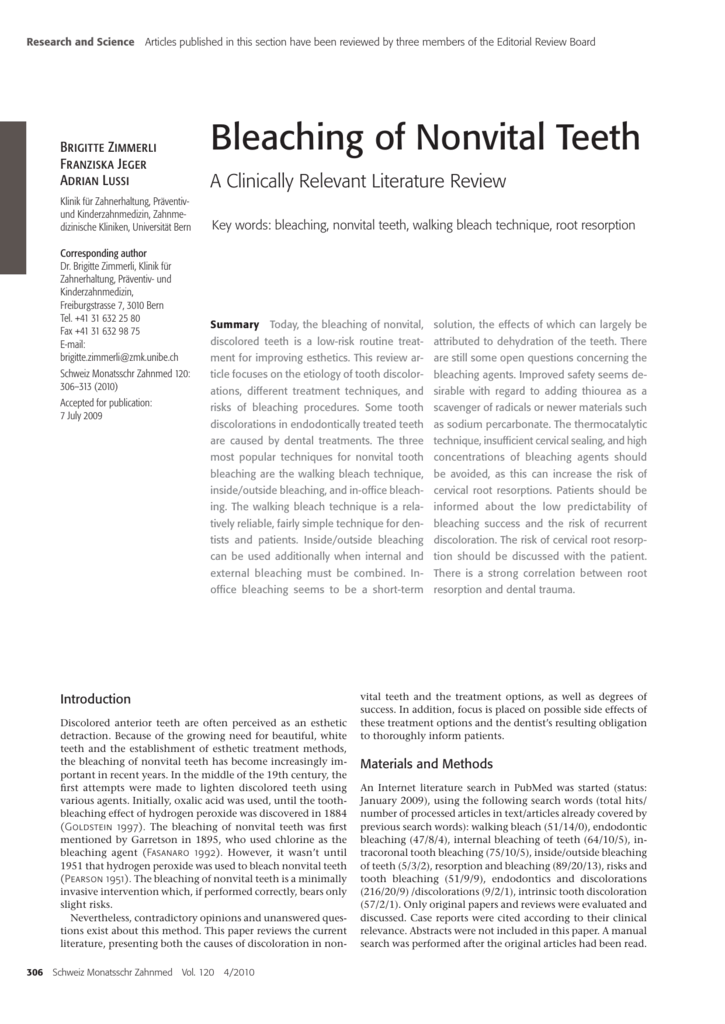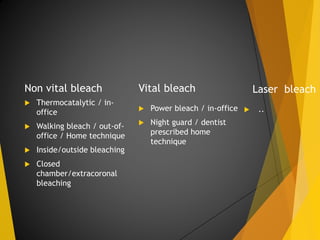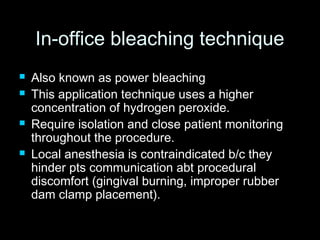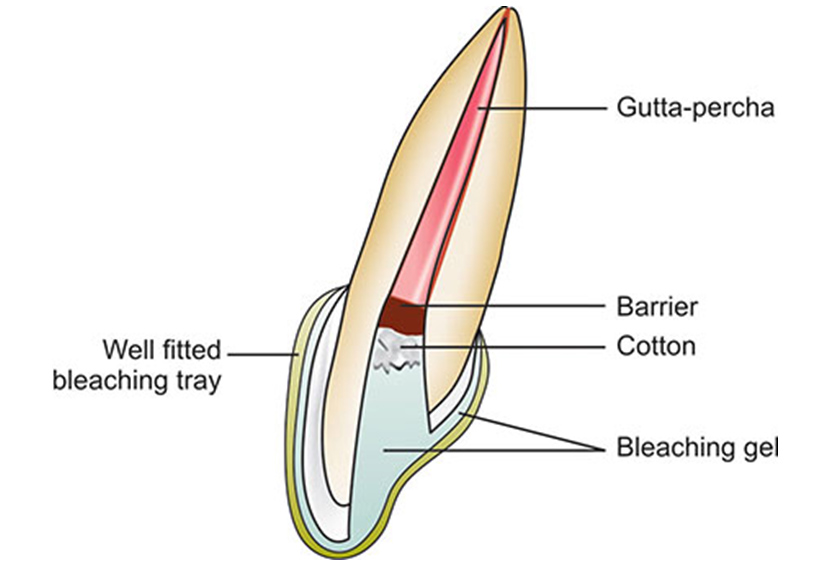walking bleach technique
The two basic techniques are the thermocatalytic method and the walking bleaching techniques. The anterior dentitions are photographed using a Polaroid CU5 camera.

An Effective Bleaching Technique For Non Vital Discoloured Teeth In Children And Adolescents Semantic Scholar
The walking bleach technique is.

. The Walking Bleach Technique The Walking Bleach Technique Putter Harvey. 1989-11-01 000000 METHOD For optimum results the following technique should be adhered to. Another name of Walking Bleach is Intracoronal bleaching Used in non vital endodontically treated tooth to remove tooth discoloration.
Its use is therefore prohibited since April 2015. When the bleaching agent is applied inside the pulp chamber and sealed the bleaching occurs between dental appointments via the walking bleach technique. With the thermocatalytic method various forms of heat arc used to speed up the release of oxygen.
This is the general procedure for the walking bleach technique. A hole is made into the space inside your tooth. Thermo-catalytic technique involves placement of 30-35 H 2 O 2 in pulp cavity and heating it using a heated instrument or lamp 8.
Internal bleaching procedures such as the walking bleach technique can be used for whitening of discoloured root-filled teeth. The purpose of this study was to compare the in vitro sealing capacity of five materials each used as a temporary sealing agent for the walking bleach technique. They replaced water by 30 hydrogen peroxide which is called the walking bleach technique.
This technique is a conservative alternative to a more invasive esthetic treatment such as. Opalescence Endo non-vital whitening gel is formulated specifically to whiten endodontically treated discoloured teeth using the walking bleach technique. Before the placement of bleaching gel Opalescence Endo into the tooth the so-called pulp chamber inside the tooth needs to be cleaned with a drill.
Once Opalescence Endo gel is delivered to the pulp chamber it should be sealed with a temporary cement and left in the tooth for one to five days. Among tfie bleaching techniques the walking bleach technique with sodium perborate associated with water or hydrogen peroxide stands out because of its esthefic re- sults and safety. Over the past decades the walking bleach technique using sodium perborate was considered a safe and effective method to bleach nonvital discolored teeth.
Private Practice Lindenhurst New York. Opalescence Endo non-vital whitening gel is formulated specifically to whiten non-vital endodontically treated teeth using the walking bleach technique. Traumatic dental injuries pulp necrosis pulp tissue remnants after endodontic therapy internal resorption etc can be effectively and safely corrected with walking bleach internal bleaching technique.
The tooth involved is usually non vital and should be endodontically treated. Given by Nutting and Poe. This technique traditionally has been used to treat.
Walking bleach technique has proven to be a successful method in management of such cases. Initial tooth color using an appropriate shade guide is documented. Bleaching gel is then placed inside the pulp chamber and the tooth is covered with provisional filling substance.
Intra-coronal bleaching with Walking Bleach technique is a widely accepted procedure when it comes to t he treatment of such an anterior discolored teeth. A material is placed over the top of the root canal filling to protect the tooth from the bleaching agent. However sodium perborate has been classified as carcinogenic mutagenic and toxic for reproduction by European Union legislation.
A modified wali. Easy to place inside pulp chamber. An external bleaching using carbamide peroxide gel may also be used for bleaching of endodontically treated teeth 7.
Nonvital bleaching was performed with a walking bleaching technique consisting of four sessions of bleach application. The bleaching gel needs to be replaced several times to achieve the desired results. Spasser introduced the application of sodium perborate and water in the pulp chamber of root canal-treated tooth to bleach the discolored nonvital teeth in 1961.
Gingival crevicular fluid samples were taken in order to quantify the RANK-L and IL-1β levels by enzyme-linked immunosorbent assay. 1 In 1963 this technique was modified by Nutting and Poe. Not intended for use in traumatized teeth any sign of cervical resorption or after previous multiple.
Address reprint requests to Harvey Putter DDS 672 North Wellwood Avenue Lindenhurst NY 11757. Tooth discolouration as a result of intrapulpal hemorrhage ie. Walking Bleaching Singh AK Singh AK or water is placed in the pulp chamber and sealed for periods of 3 to 7 days.
All teeth received traditional biomechanical root canal instrumentation after which the walking bleach agent was placed in the pulp chamber space. Walking bleach is a bleaching procedure performed at a dental clinic. Vaseline is applied to the lips and a rubber dam is applied to the tooth being whitened.
It was introduced by Spasser and later. The primary difference between the two methods is the way in which nascent oxygen is released from the chemicals.

Bleaching Of Nonvital Teeth Swiss Dental Journal Sso Mit

Bleaching Of Discoloured Tooth Ppt

Pdf The Efficacy Of Walking Bleach Technique In Endodontically Treated Teeth Case Report

Pdf Non Vital Tooth Bleaching Techniques A Systematic Review Semantic Scholar
Intracoronal Bleaching Of Nonvital Tooth Teeth Whitening

Pdf Walking Bleach With Sodium Perborate Tetrahydrate A Safer Material And Method

Pdf Non Vital Tooth Bleaching Techniques A Systematic Review

Dos And Donts In Dentistry Walking Bleach Technique

Intracoronal Bleaching Of Nonvital Teeth Pocket Dentistry

Dos And Donts In Dentistry Walking Bleach Technique

Kids Are Using Too Much Toothpaste Bad Dental Health Habits Delta Dental Of Arizona Blog Tips For Healthy Teeth Happy Smiles Dental Health Health Habits Mouth Health







Comments
Post a Comment